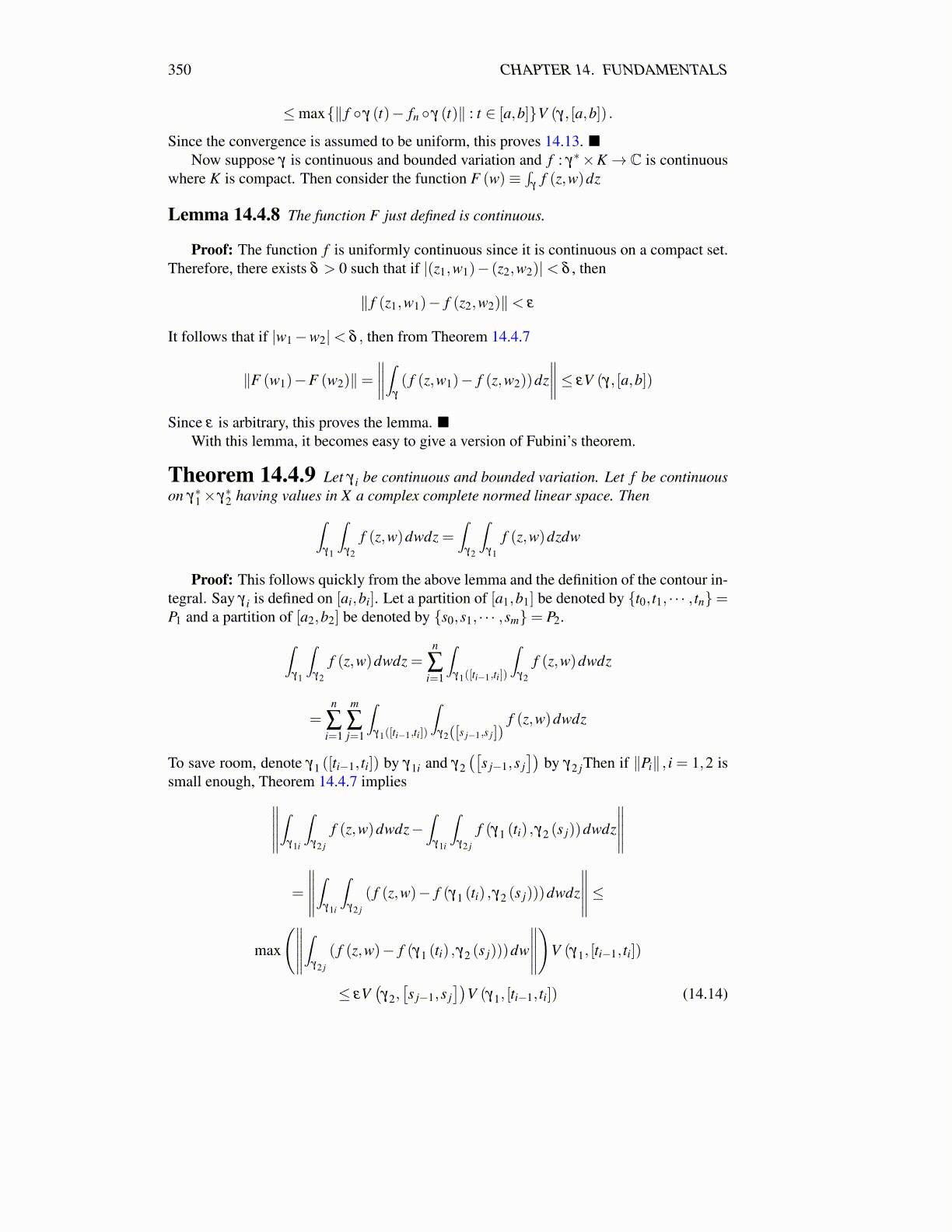
350 CHAPTER 14. FUNDAMENTALS
≤max{∥ f ◦ γ (t)− fn ◦ γ (t)∥ : t ∈ [a,b]}V (γ, [a,b]) .
Since the convergence is assumed to be uniform, this proves 14.13. ■Now suppose γ is continuous and bounded variation and f : γ∗×K→ C is continuous
where K is compact. Then consider the function F (w)≡∫
γf (z,w)dz
Lemma 14.4.8 The function F just defined is continuous.
Proof: The function f is uniformly continuous since it is continuous on a compact set.Therefore, there exists δ > 0 such that if |(z1,w1)− (z2,w2)|< δ , then
∥ f (z1,w1)− f (z2,w2)∥< ε
It follows that if |w1−w2|< δ , then from Theorem 14.4.7
∥F (w1)−F (w2)∥=∥∥∥∥∫
γ
( f (z,w1)− f (z,w2))dz∥∥∥∥≤ εV (γ, [a,b])
Since ε is arbitrary, this proves the lemma. ■With this lemma, it becomes easy to give a version of Fubini’s theorem.
Theorem 14.4.9 Let γ i be continuous and bounded variation. Let f be continuouson γ∗1× γ∗2 having values in X a complex complete normed linear space. Then∫
γ1
∫γ2
f (z,w)dwdz =∫
γ2
∫γ1
f (z,w)dzdw
Proof: This follows quickly from the above lemma and the definition of the contour in-tegral. Say γ i is defined on [ai,bi]. Let a partition of [a1,b1] be denoted by {t0, t1, · · · , tn}=P1 and a partition of [a2,b2] be denoted by {s0,s1, · · · ,sm}= P2.∫
γ1
∫γ2
f (z,w)dwdz =n
∑i=1
∫γ1([ti−1,ti])
∫γ2
f (z,w)dwdz
=n
∑i=1
m
∑j=1
∫γ1([ti−1,ti])
∫γ2([s j−1,s j])
f (z,w)dwdz
To save room, denote γ1 ([ti−1, ti]) by γ1i and γ2([
s j−1,s j])
by γ2 jThen if ∥Pi∥ , i = 1,2 issmall enough, Theorem 14.4.7 implies∥∥∥∥∥
∫γ1i
∫γ2 j
f (z,w)dwdz−∫
γ1i
∫γ2 j
f (γ1 (ti) ,γ2 (s j))dwdz
∥∥∥∥∥=
∥∥∥∥∥∫
γ1i
∫γ2 j
( f (z,w)− f (γ1 (ti) ,γ2 (s j)))dwdz
∥∥∥∥∥≤max
(∥∥∥∥∥∫
γ2 j
( f (z,w)− f (γ1 (ti) ,γ2 (s j)))dw
∥∥∥∥∥)
V (γ1, [ti−1, ti])
≤ εV(γ2,[s j−1,s j
])V (γ1, [ti−1, ti]) (14.14)